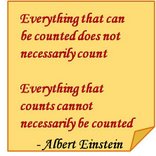A tear in my knee cartilage has meant that I frequented a physical therapist – where I was often asked to give a report on the nature and extent of pain I felt.
I started to describe it but something just did not feel right…
I did not have the right words – resulting in a 2 minute long winding sentence - that gave the therapist only a vague idea of what I felt inside
The therapist tried to understand more by asking me questions….which did not do either of us any good
Was it a stretch or a pain? I could not discern
Was it bearable / unbearable? Even if it is bearable – what does that tell you – my threshold for bearing pain could be far higher than that of another individual
How would you rate it from 0 to 10 where zero is no pain and 10 is the maximum?
How do I know what maximum pain feels like? It certainly is not zero, but unless I don’t know the maximum where do I pitch it on the scale?
The whole experience reinforced two things I have known and learnt but haven’t paid enough attention to – perhaps the first hand experience was necessary to appreciate the nuances
a) Emotions are subconscious. Emotions surpass language. Language offers a surrogate way of understanding emotions but words cannot totally and accurately describe what one feels. Try articulating - what you feel when you feel happy / what it means to be in love...and you'll find yourself grappling for words
b) Emotions are felt and sensed as an amalgamation of visuals, images, sensations – its difficult to isolate these sensory perceptions and describe them individually. Also some of these sensations are so subtle and so much beyond our conscious understanding and expression that even if you know how you feel – translating it to words for even a reasonably articulate person is quite an uphill task
All this makes me now a little more sympathetic and sensitive towards research respondents who say ‘I just cannot describe how I feel on seeing this ad’ or worse still remain silent or say I don’t feel anything at all. Those are not just respondents behaving lazy or indifferent. Those are very real flaws in the way we question consumers and design research.
Visualizing emotions may help – asking consumers to close their eyes and
Describe what they see, hear, smell
Where in their body they see it
The colors / images they see or the sounds they hear etc
An exercise in visualizing emotions could not only make it easier for consumers to articulate those – (rather than trying to answer a blanket question like what do you feel?) but also it could offer cues that could be used in designing communication.
(Where is the emotion felt in the body / how it is seen inside etc – for instance adverts for pain relieving tablets often show pain in originating from the affected part in concentric circles and warm colors)
Doing this exercise while the consumer is mentally relaxed with his eyes shut – would mean a greater probability that his focus / attention is inward driven
If getting a rating on the emotion is crucial to the research design then design a scale that is more consumers friendly. This is one good example I found (read last para) where the scale uses everyday experiences from the consumer’s life as benchmarks – rather than abstract descriptors.
This brings me to a related issue – how appropriate is it to compare / aggregate responses pertaining to emotions – since emotions are a very subjective an individual experience, perhaps also influenced by the cultural set up one is part of.
For example – one child understands of pain or happiness - could depend on his experiences / what he is made to understand about pain by his peers or influencers, the physical, emotional, social environment he grew up in.
I guess this would deserve some more reading and another post.
Sep 1, 2006
Describing pain…On how can research be designed to help consumer’s articulate emotions?
Posted by
Reshma Bachwani
at
5:00 AM
![]()
Labels: Research Design
Subscribe to:
Post Comments (Atom)

No comments:
Post a Comment